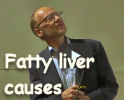Ozempic, obesity, and the modern food trap
 Ozempic is the new "miracle" drug on the market, although it's not a new drug, it's just a successful drug used for diabetes control that has been re-purposed for weight loss.
Ozempic is the new "miracle" drug on the market, although it's not a new drug, it's just a successful drug used for diabetes control that has been re-purposed for weight loss.
 Ozempic is the new "miracle" drug on the market, although it's not a new drug, it's just a successful drug used for diabetes control that has been re-purposed for weight loss.
Ozempic is the new "miracle" drug on the market, although it's not a new drug, it's just a successful drug used for diabetes control that has been re-purposed for weight loss.

 Or should we look at the causes of fatty liver?
Or should we look at the causes of fatty liver?
 This medical research arises from the pandemic problem of fructose in our processed food, which is the major cause of Non-alcoholic fatty liver disease (NAFLD), which accompanies the terrible scale of modern obesity. This hepatitis-related obesity carries high risks of dementia, cirrhosis, and cancer. The effects are similar to those of alcoholism, but awareness of risks is even lower. This study identifies fructose as doing its damage by causing changes to the barrier function of the intestine, which is a new understanding of how the liver-disease starts. The study proposes the idea that a genetic intervention might, at some time in the future, prevent these changes to some degree, in people very seriously affected. It points to genetic interventions in mice made ill by high fructose-induced diets. The authors of the study note that it would, of course, be better not to ingest the fructose. We have also embedded a video about fructose from the U of California.
This medical research arises from the pandemic problem of fructose in our processed food, which is the major cause of Non-alcoholic fatty liver disease (NAFLD), which accompanies the terrible scale of modern obesity. This hepatitis-related obesity carries high risks of dementia, cirrhosis, and cancer. The effects are similar to those of alcoholism, but awareness of risks is even lower. This study identifies fructose as doing its damage by causing changes to the barrier function of the intestine, which is a new understanding of how the liver-disease starts. The study proposes the idea that a genetic intervention might, at some time in the future, prevent these changes to some degree, in people very seriously affected. It points to genetic interventions in mice made ill by high fructose-induced diets. The authors of the study note that it would, of course, be better not to ingest the fructose. We have also embedded a video about fructose from the U of California.
 [Candobetter Ed: NAMES FOR FRUCTOSE: Fructose is a component of sugar (sucrose). The following ingredients all contain fructose: Brown sugar, corn sweetener, corn syrup, dextrose, fructose, glucose, high-fructose corn syrup, honey, lactose, malt syrup, maltose, molasses, raw sugar and sucrose.]
[Candobetter Ed: NAMES FOR FRUCTOSE: Fructose is a component of sugar (sucrose). The following ingredients all contain fructose: Brown sugar, corn sweetener, corn syrup, dextrose, fructose, glucose, high-fructose corn syrup, honey, lactose, malt syrup, maltose, molasses, raw sugar and sucrose.]
A team of international researchers including Monash University academics has discovered that, contrary to previous belief, fructose causes liver toxicity by changing the barrier function of the intestine.
The new study, published today (August 25th) in Nature Metabolism, shows that fructose affects the liver only after it causes intestinal barrier disruption, therefore treatments that prevent barrier disruption could protect the liver from fructose-induced diseases including non-alcoholic fatty liver disease (NAFLD), fibrosis and cancer.
Fructose is a simple sugar which can be found in high quantities in soft drinks, sauces and fast foods. With the advent of modern biochemistry and metabolic analysis, in recent times scientists have discovered that fructose is up to three times more potent than glucose in increasing liver fat.
Excessive fructose consumption has been linked to the recent surge in Nonalcoholic fatty liver disease (NAFLD) - one of the most common metabolic disorders - and its associated co-morbidities, which include liver failure, cirrhosis, and cancer.
Australian metabolic disease expert, Professor Mark Febbraio from Monash’s Institute of Pharmaceutical Sciences, was part of the international team of researchers led by Professor Michael Karin from The University of California San Diego, School of Medicine.
Professor Febbraio says:
“The findings from this study make it clear that fructose does its damage in the intestine and if intestinal barrier deterioration is prevented, the fructose does little harm to the liver.”
The intestine is an organ that makes up part of the gastrointestinal system (more commonly known as the gut). In recent years it’s become evident that excessive fructose metabolism in the gut reduces the production of proteins that maintain the gut barrier, which can lead to a chronic inflammation condition called endotoxemia, as documented in animal studies and paediatric NAFLD patients.
The international team of researchers found that by adding a cell signalling protein called ‘tumor necrosis factor’ (TNF) to hepatocytes stimulates the metabolism of fructose and increases the production of the enzymes that convert the molecule ‘acetyl CoA’ to fatty acids.
“A large increase in the expression of these enzymes was also detected in livers of fructose-fed mice,” says Professor Febbraio. “Conversely, genetic modification that reduced TNF production was found to protect mice from fructose-provoked NAFLD, which is a very exciting step forward for the treatment of diseases which can evolve from this all too common liver disorder.”
Although education and increased awareness are the best solutions to the problem of fructose-induce liver disease, for those individuals who progress to the severe form of NAFLD, known as non-alcoholic steatohepatitis (NASH), the findings described in this study offer some hope of a future therapy based on gut barrier restoration.
This study clearly demonstrates that maintaining gut barrier integrity is a therapeutic target to treat liver disease associated with high fructose consumption.
The researchers will now focus on screening drug candidates that target key proteins in the maintenance of gut barrier integrity.
The full study can be found at: https://www.nature.com/articles/s42255-020-0261-2
 Life-threatening liver disease is skyrocketing in Australia, with alcohol and hepatitis C and now obesity-related fatty liver disease on the rise. The average age of death of these patients is in their mid-50s. Non-alcoholic fatty liver disease (NAFLD) affects one in four Australian adults and has been increasing in parallel with the rising prevalence of obesity and diabetes in the community. It is argued that some simple measures, including regular contact with specially trained nurses, can greatly improve outcomes for this chronic condition, which sometimes is poorly understood and mismanaged by patients and their medical and nursing systems. This article comes from a press release from Flinders University, but candobetter.net has included a video about the effects of commercial quantities of fructose on the liver, from Dr Lustig, of the University of California. We spoke to Associate Professor Alan Wigg, Flinders University College of Medicine and Public Health and Head of Hepatology and the Liver Transplantation Medicine Unit, Flinders Medical Centre, who agreed that fructose has a role in the cause of fatty liver. He says that this Flinders University study is particularly looking at how to help people whose liver disease has progressed to an advanced stage.
Life-threatening liver disease is skyrocketing in Australia, with alcohol and hepatitis C and now obesity-related fatty liver disease on the rise. The average age of death of these patients is in their mid-50s. Non-alcoholic fatty liver disease (NAFLD) affects one in four Australian adults and has been increasing in parallel with the rising prevalence of obesity and diabetes in the community. It is argued that some simple measures, including regular contact with specially trained nurses, can greatly improve outcomes for this chronic condition, which sometimes is poorly understood and mismanaged by patients and their medical and nursing systems. This article comes from a press release from Flinders University, but candobetter.net has included a video about the effects of commercial quantities of fructose on the liver, from Dr Lustig, of the University of California. We spoke to Associate Professor Alan Wigg, Flinders University College of Medicine and Public Health and Head of Hepatology and the Liver Transplantation Medicine Unit, Flinders Medical Centre, who agreed that fructose has a role in the cause of fatty liver. He says that this Flinders University study is particularly looking at how to help people whose liver disease has progressed to an advanced stage.
Dr Lustig of the University of California has published numerous papers and videos about obesity and the effects on the liver of fructose. There are now many other resources online about this. We have included this information because we believe that Australians have very little information on how to prevent fatty liver, and that fructose is a major factor.
Life-threatening liver disease is skyrocketing in Australia, with alcohol and hepatitis C and now obesity-related fatty liver disease on the rise. (Refer to published detailed scientific paper accompanying this article here: Mahady_et_al-2018-Journal_of_Gastroenterology_and_Hepatology (1).pdf.)
In the past 10-15 years, the number of chronic liver failure cases at South Australia’s public hospitals has increased more than three-fold from 422 in 2001 to 1441 in 2015. Meanwhile, obesity-related liver disease is expected to become a modern epidemic by 2050.
Now Australia’s National Health and Medical Research Commission (NHMRC) has announced major funding for researchers at Flinders University and their partners at several major SA and WA public hospitals to develop a model of care to improve outcomes for these at-risk patients.
“With the average age of death of these patients in their mid-50s, this represents a huge loss for individuals, their families and for the community,” says Flinders University Associate Professor Alan Wigg, the lead investigator in the $900,000 combined partnership grant.
“The program we’re developing will aim to address the elephant in the room, that is the economic and health system cost of these patients and their devastating disease,” he says. “It will help to address the multiple and complex barriers that prevent health systems from being able implement many of the highly effective treatments that currently exist.”
Nationally, more than 6 million Australians suffer from chronic liver disease with more than 7000 deaths a year – all part of the effects of chronic conditions such as alcohol, hepatitis C, and non-alcoholic fatty liver disease (NAFLD).
A previous Deloitte study indicates the cost of managing the rising tide of chronic liver disease – including lost productivity – now exceeds $50 billion a year in Australia alone.
A previous trial by Flinders University, Flinders Medical Centre and other SA Health researchers showed that patients managed under a chronic liver failure program supervised by liver specialists within a coordinated care model had a 48% lower rate of liver-related emergency readmissions and significantly improved (67.7% versus 37.2 %, p=0.009) three-year survival than patients managed with standard care.
Not being managed in the hospital with a coordinated care model was independently associated with a 2.5-fold higher risk of mortality.
In an influential small randomised pilot trial, the research team previously demonstrated some important clinical benefits of managing this patient group with a different style of care. The “co-ordinated care model” was associated with improvement in quality of care and encouraging trends towards less emergency admissions and lower mortality.
“We argue that some simple measures, including regular contact with specially trained nurses, can greatly improve outcomes for this chronic condition, which sometimes is poorly understood and mismanaged by patients and their medical and nursing systems,” says Associate Professor Alan Wigg, an FMC gastroenterologist and researcher at the Flinders University.
The NHMRC Partnership Project maximises the impact of research funding through key collaborations that ensure rapid translation of research to the benefit of patients and health-care systems, says Flinders University Deputy Vice-Chancellor (Research) Professor Robert Saint.
“Based on previous pilot studies, expanding this research into a multicentre trial is aiming to result in fewer liver-related emergency department visits and fatalities,” Professor Saint says. “Further research on liver disease, including cirrhosis, could help patients to lead better lives and present less frequently for emergency treatment at our hospitals.”
The new project aims to reduce emergency department admissions, improve mortality rates, give patients more nursing support following discharge and more health information and better general quality of care. It is hoped that benefits will also be reduced overall cost to the health system.
Cirrhosis is a very serious and complex form of liver disease which is often not well managed, adds Associate Professor Leon Adams, from the Sir Charles Gardiner Hospital in Perth, which is one of the four Australian hospitals involved in the latest research.
“Non-alcoholic fatty liver disease (NAFLD) affects one in four Australian adults and has been increasing in parallel with the rising prevalence of obesity and diabetes in the community,” says Associate Professor Adams.
“A minority of people develop cirrhosis, however this appears increasingly common with NAFLD cirrhosis the fastest growing indication for liver transplantation in Australia and New Zealand.”
Recent comments